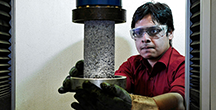 Lutfur Akand saw the devastation of flooding and the danger of groundwater depletion when he was growing up in Bangladesh. Now the NDSU doctoral student in civil and environmental engineering is working toward a solution to both problems.
Lutfur Akand saw the devastation of flooding and the danger of groundwater depletion when he was growing up in Bangladesh. Now the NDSU doctoral student in civil and environmental engineering is working toward a solution to both problems.
Akand is developing porous concrete that is durable and strong enough to withstand high-force impacts, heavy loads and extreme freeze-thaw environments.
Porous concrete, which is also known as pervious concrete, is manufactured with very few small pebbles, or what people in the industry call fine aggregate. The larger stones that remain in the mixture create air pockets that allow water to flow through to the soil and the water reserves below. The problem is that, with all those air pockets, porous concrete is weaker than regular concrete and prone to cracking.
Akand’s solution? Fibers.
Fibers have been used to strengthen concrete for decades. Porous concrete has been around for a long time, too, but so far no one has figured out how to manufacture it in a way that maintains porosity while addressing the strength and durability issues.
Drainage systems are often used to remove water from large airport runways, highways and large parking lots, but they can be expensive. They also add more concrete to a project, which hinders the flow of water even further. That, in turn, keeps soil from fulfilling one of its most important functions, which is acting as a sieve to remove pollutants before water reaches aquifers.
“I could have used chemicals, but since water will pass through the concrete and it will be exposed to the environment, that was not an option for me,” said Akand, who is working under the direction of Mijia Yang, assistant professor of civil and environmental engineering. “Fiber reinforcement was a better solution, but the question was what kind of fibers should I use? There are thousands of fibers on the market, and I couldn’t just buy them all and test them one by one in the lab.”
He solved the problem by creating a computer model that analyzes a wide range of variables, from void ratio to how much strength specific fibers add to a mix. Using the software, he can test thousands of fibers and fiber-concrete mixes virtually rather than doing it by hand in the lab.
To ensure the model would replicate real-world scenarios, Akand started by going inside porous concrete with a microscope and taking photographs. After analyzing them he had a better idea of how pores are distributed. Then he did what is called a pull test. As the name suggests, it involved pulling fibers from the concrete to learn how much force was needed to get them out. This measured the strength of the bonds between fibers and the concrete. He also incorporated data that allows the model to test suitability of fiber-concrete mixes for different soil and environmental conditions.
The next step is to determine fiber properties and enter them into the computer program. He is running data for steel, fiberglass and polypropylene fibers, then comparing the results to hands-on testing.
Akand is now testing another characteristic that can improve the bond between fibers and concrete: coarseness. He is treating polypropylene fibers with acids to make them rougher, then adding data into the computer model related to the type of acid and how much is needed in various scenarios.
The model consistently predicts the characteristics of fiber-concrete mixes with a high level of accuracy, and Akand is continuing to refine it.
His objective is to make it as accurate and easy to work with as possible so users can identify exactly the type of fibers, fiber-to-concrete ratios, amount of roughness and other variables that will be best for their projects. That would allow city planners, contractors, developers, and state and federal transportation departments to design and construct projects that not only save time and money, but also minimize flooding and improve groundwater quality and quantity.
“Urbanization is accelerating and the world is being covered with concrete everywhere. How is water from rainfall and snowfall supposed to reach the soil?” Akand said. “Assuming my research results in a strong and durable porous concrete solution, engineers around the world will be able to use it to address these problems.”


